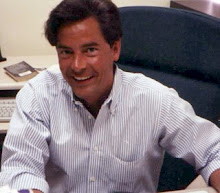As embroiderers, our biggest concern about the
appearance of our end product is
focused on the top. However, bobbin thread also plays an important role in the embroidery process. If the bobbin thread is too tight, the embroidery ill pull in, causing running stitches to disappear and columns to look too skinny. If the bobbin thread is too loose, you will see it on the top of the embroidery, and that might even be worse. In addition to tension, there are
other points to consider, such as the many different bobbin thread choice f
rom which to choose- cotton, cotton
poly blends,
monofilament polyester and spun polyester.
On top of that, it comes in many different packages, such as cones, and
pre-wound bobbins. If that isn't enough,
pre-wound bobbins come with or without cardboard sides and magnetic and non-magnetic.
In most cases we don't care what the bobbin looks like as long as the top of the embroidery looks fine. The are, however, times when the back is just as important as the front. When
embroidering on director's chairs, for example, there is not really any practical way to hide the back, so it becomes important to make sure the back looks as good as possible. Napkins and
Handkerchiefs are two more product where this also applies. One way to make the back look better is to wind your own bobbins using the same thread you
are using for the top stitching.
This will make the back of you embroidery look much the same as the top. There is also the issue of backing, when the back side of the
embroidery is visible you don't want any backing showing. For most woven fabrics you can use a tear-away backing, in which case the excess backing can be torn away after the embroidery is done. There are instances where you don't want the backing to show through the embroidery, in those cases you can use a water or heat soluble backing.
Bobbins Up
Reverse or bobbin embroidery is another process where the bobbin takes center stage. The reverse embroidery
technique uses the bobbin thread as the finishing thread. This is usually accomplished using
metallic or floss thread in the bobbin case, which you combine with a similarly colored rayon thread in your needle. Since the
finished side is the back side, make sure that you hoop the fabric upside down. Your tensions should be set so that the bobbin thread is pulled to the top of side of the fabric. (loose bobbin, tight top thread) This will ensure that the top thread is invisible in the finished embroidery. Because in the case of floss, you are working with heavier thread, your density should be lowered to about 30 stitches per inch. The finished result will look as though the the thread was hand- sewn using a loop stitch from the bottom.
The thread you choose for your bobbin can have a
profound effect on your finished product. It can add to the professional look of the design, it can add texture or it can even make up
your finished design. These are just some of the options that you have for bringing you bobbin thread to the forefront of your
embroidered creations.


